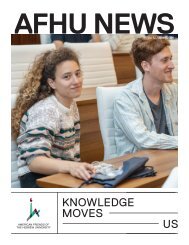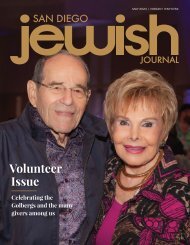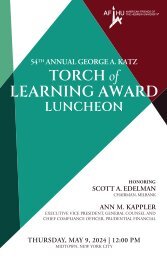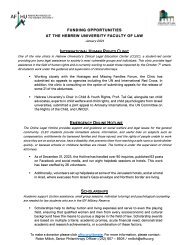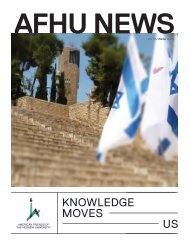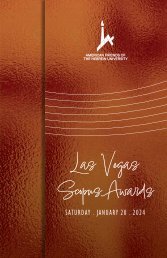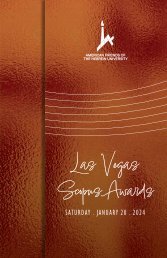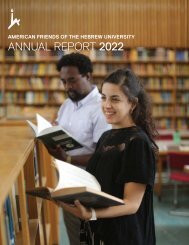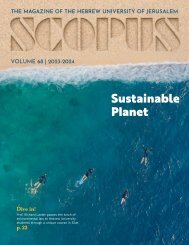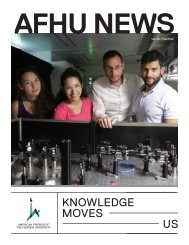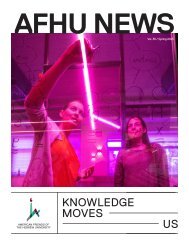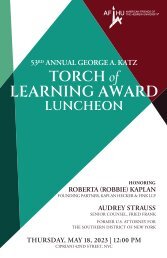SCOPUS
You also want an ePaper? Increase the reach of your titles
YUMPU automatically turns print PDFs into web optimized ePapers that Google loves.
Passion Projects<br />
Photo by Israel's Government Advertising Agency<br />
aChord: Social Psychology for Social<br />
Change – Translating Social Psychology<br />
Research into Practice<br />
Prof. Eran Halperin is a researcher of social psychology.<br />
He applies psychological and political theories<br />
and methods to investigating different aspects of intergroup<br />
relations and conflicts.<br />
On campus, Halperin heads the Psychology of<br />
Intergroup Conflict & Reconciliation Lab, while<br />
off-campus he founded and heads aChord: Social<br />
Psychology for Social Change. aChord was founded<br />
in 2016 to translate academic research into practical<br />
tools for organizations working to create social change,<br />
including combatting racism and discrimination.<br />
The center’s vision is to promote equal, tolerant, and<br />
respectful intergroup relations – both within Israeli<br />
society and between Israel and its neighbors. To that<br />
end, aChord conducts research, develops workshops<br />
and trainings, designs tools and interventions, and<br />
consults partner organizations to better understand<br />
and address the psychological barriers that stand in<br />
the way of optimizing their effectiveness.<br />
Two of aChord’s main foci are employment and<br />
education. In terms of the former, aChord promotes<br />
the integration of Arab citizens of Israel into the<br />
workforce by working with companies and job<br />
applicants. During 2019/20, the center ran diversity<br />
and inclusion trainings for 31 companies and<br />
organizations, offering a total of 42 workshops in<br />
which 550 people participated. Since the program’s<br />
inception in 2016, a total of 1,800 participants have<br />
gone through these trainings. Next, the center plans<br />
to begin a similar process with the ultra-Orthodox<br />
sector.<br />
Working with aChord has changed how<br />
“<br />
we see people and how we build on the<br />
strengths of individuals who are part of<br />
this company.<br />
”<br />
T., CEO of a high-tech company<br />
On the educational front, aChord works to promote<br />
education for shared society in myriad schools all over<br />
Israel. During 2019/20, aChord worked with 21 schools<br />
and 20 teacher communities nationwide, working<br />
directly with 3,800 students who participated in<br />
workshops and other activities. Another 2,200 students<br />
were impacted indirectly, through their teachers’<br />
participation in aChord’s teacher communities.<br />
I really enjoyed the classes. They gave<br />
“<br />
me the ability to see the bigger picture of<br />
where I stand in the world. I recommend<br />
having these classes in other schools<br />
because they open your mind to new<br />
opinions and thoughts.<br />
”<br />
N., student-participant<br />
aChord staff presenting Tav Tikva Israelit (Standard for Israeli Hope) at the official residence of President Reuven Rivlin. aChord spearheads this<br />
shared society program, which is a partnership with the President of Israel and the Lautman Fund.<br />
The Living Lab in Memory of Noam Knafo z”l<br />
Prof. Inbal Arnon (Psychology) studies the acquisition,<br />
processing, and representation of language. Prof. Ariel<br />
Knafo-Noam (Psychology) studies the development of<br />
pro-social behavior and empathy among children.<br />
In 2014 they founded Israel’s first and only Living Lab,<br />
located in the Bloomfield Science Museum adjacent<br />
to the Edmond J. Safra Campus. The Lab welcomes<br />
visiting families, where the children participate in<br />
a short, fun activity that teaches them about the<br />
science of child development while simultaneously<br />
contributing to it. While children participate in studies,<br />
parents can discuss current research in the field of child<br />
development with the Lab’s staff.<br />
The Living Lab is a great example of<br />
“<br />
effective community outreach that also<br />
generates cutting-edge science. It is a<br />
win-win situation: we get to widen the<br />
scope of our developmental research while<br />
educating children (and parents) about the<br />
beauty and importance of science.<br />
”<br />
Prof. Inbal Arnon<br />
In founding the Lab, Arnon and Knafo-Noam aimed<br />
to make developmental findings accessible to parents<br />
and the community at large; conduct cutting-edge<br />
developmental science; and expose children to scientific<br />
research that involves people as a way of increasing<br />
children’s interest in science.<br />
To date, the Lab has hosted eight researchers from different<br />
fields. In 2019/20 alone (when the pandemic forced the<br />
museum to close for extensive periods of time), the Lab<br />
hosted 15 separate studies. Over the years, findings from<br />
the Lab have been the basis for 50 conference presentations<br />
and 20 journal publications. The Lab has also trained<br />
numerous undergraduate and graduate students how to<br />
conduct developmental research.<br />
The vision of the lab is to expand its<br />
“<br />
activities to include children from groups<br />
underrepresented in research.<br />
”<br />
Prof. Ariel Knafo-Noam<br />
Over 8,000 children have participated in these<br />
activities, sparking conversations about science and<br />
strengthening their affinity to the field. In addition, Lab<br />
staff have talked with thousands of parents.<br />
In terms of findings, Living Lab researchers were the<br />
first to demonstrate that motivational principles shape<br />
children’s values already at age five and that children’s<br />
values at this age predict their generosity. Researchers<br />
have added crucial evidence to the nature/nurture<br />
debate by showing that children and adults play a<br />
different role in the emergence of linguistic structure<br />
(using a creative Chinese telephone game), and that<br />
children’s statistical learning abilities change with age.<br />
Photo by Yael Ilan<br />
34<br />
| 2020-2021 | 2020-2021 35



